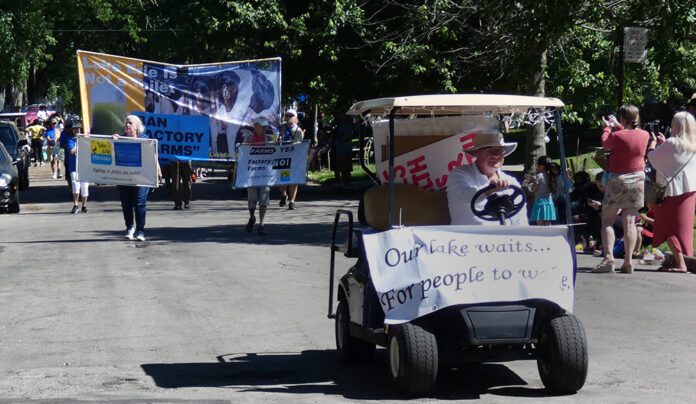Legal action in Federal Court against the U.S. Environmental Protection Agency (EPA) for failing to do right by Lake Erie is in its seventh year, going on eight.
Lake Erie Advocates (LEA) was the original plaintiff in a suit to force EPA to clean up Lake Erie, first filed in 2017. We withdrew under protest four years later, but according to local news updates on the lawsuit’s new participants, that part of the story has gone down the memory hole.
When the Environmental Law and Policy Center, out of Chicago, came looking for local plaintiffs so it could have standing to sue the U.S. EPA, all the likely candidates, except LEA, said “No, thank you,” including the city, county, the Ohio Environmental Council, Lake Erie Waterkeeper and the Lake Erie Foundation.
Maybe it was an intimidating request; I don’t know. But I do know that LEA, then known as Advocates for a Clean Lake Erie, said “YES!” in a heartbeat. There was no cost involved and we hoped something good would result.
For over four years we were active plaintiffs, publicizing the suit at every opportunity and letting the attorneys know, to no avail, of valuable insights we had learned from our research. lronically, that research eventually led us to withdraw as a plaintiff in 2021.
Our initial enthusiasm about the suit was spurred by what looked like real progress cleaning up Chesapeake Bay under the U.S. Clean Water Act. TMDLs (total maximum daily loads), a term that would become familiar in Toledo, were pointed to as the reason oyster beds were returning and other water quality indexes improved.
But the more we learned about the differences between Chesapeake Bay and Western Lake Erie, and the more we learned about what TMDLs would mean in our case, the less optimistic we became.
We learned that:
- Subsurface drainage, the “field tiles” so ubiquitous in our former Great Black Swamp watershed, are not an issue in the Chesapeake watershed.
- When billions of gallons of liquid, untreated animal waste is dumped on farm fields, it quickly hit those subsurface drains and heads straight for the nearest ditch or stream, eventually ending up in Lake Erie.
- Hundreds of millions of dollars the state and feds spend on programs, like H2Ohio, are mostly a “See, we’re doing something about the lake” smokescreen. Our research showed that in different parts of the country, those very same methods, such as buffer strips, no-till and cover crops, had uneven results at best, and, at times, even made the problem worse. And those methods were the majority of what the Ohio EPA wrote into the TMDLs for Lake Erie.
- There’s a vast difference between Total Phosphorus (TP) and Dissolved Phosphorus (DP) when determining success or failure of H2Ohio programs. The Ohio EPA planned to measure success based on reductions in TP, something that meant little to politicians or even the attorneys in the lawsuit at first, but is of utmost importance to the lake.
- Factory “farming” condemns some 30 million confined animals in our watershed to a living hell, regardless of whether the lake can be improved. If one cares about other living things, this fight is over more than just water quality.
After four years of active support for the lawsuit, LEA came to the conclusion that we could no longer be a plaintiff in something that would require us to declare victory over what would be a mirage. We withdrew, explaining why in this December 2021 news release and in this Channel 13 clip from the news conference.
Any of the above points would be appropriate to include in news updates, but the dominant narrative of Lake Erie will not allow it. The lawsuit, the H2Ohio budgets, statements of elected officials and most environmentalists are all about “how can we fix this industry’s environmental problems?”
Nothing outside that frame is allowed in the picture; certainly not a statement that there is no “fixing” this industry, that we need to return to time-tested methods of raising animals in more humane and sustainable ways. Until 1995, there were no factory “farms” in our watershed and shoppers never once found empty shelves in the milk, egg and meat departments.
If you say current law is incapable of fixing the problem, it’s like daring to say the king has no clothes. The charade and the expense must continue. The Lake Erie Bill of Rights was an attempt to move beyond current law, but it was squashed by a corporate-sponsored lawsuit the day after Toledo voters approved it overwhelmingly in February 2019.
Extending legal rights to nature so it is not considered simply property to exploit is a necessary concept that may never arrive in time.
Factory “farming” is a method of raising livestock that has been researched and developed with our tax dollars and continues to be propped up by them. It is killing Lake Erie, destroying family farms, confining millions of animals in lifelong cruelty and incubating the next pandemic … but it must continue because, well … because it’s now part of the system.
The guardians of reality in the press, the courts and government agencies allow the debate to go only so far. Only certain questions can be asked. Somehow we must live with this madness and figure out how to make it a little less harmful. You can bet that if the lake didn’t turn green every summer we would still be in denial.
As the lawsuit grinds on with plaintiffs who initially declined to join it and more who’ve recently piled on, Lake Erie Advocates will continue to tell the public all the costs of a system we had absolutely no voice in creating.
The salvation of the lake and the animals will happen only if enough people care. As one of our banners in the Old West End parade said a few years ago: “Our lake waits for people to wake.”















I’ve been a part of LEA since its inception. Yet I still need the bullet list Mike provides in this piece, all backed up with deep-level research by citizen-activists, to keep reminding me that when all we are about is the superficial–the sound-bites–we will never accomplish a legacy for those who come afterwards. I’d much rather read longer pieces by the informed and dedicated (statistics and all) than all the tweets a human can possibly post. LEA, under Mike’s leadership and with the hard work of many others who keep researching and doing what is unpopular…until it isn’t…are the hopes for citizens and sentient animals alike. “They tried to bury us. They didn’t know we were seeds.” Dinos Christianopoulos